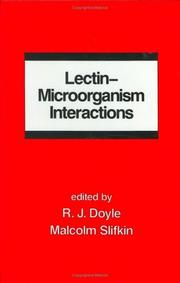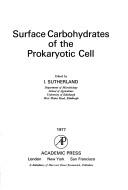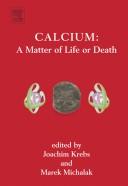| Listing 1 - 10 of 15 | << page >> |
Sort by
|
Book
ISBN: 1789856426 1789856418 Year: 2020 Publisher: London, United Kingdom : IntechOpen,
Abstract | Keywords | Export | Availability | Bookmark
 Loading...
Loading...Choose an application
- Reference Manager
- EndNote
- RefWorks (Direct export to RefWorks)

Abstract | Keywords | Export | Availability | Bookmark
 Loading...
Loading...Choose an application
- Reference Manager
- EndNote
- RefWorks (Direct export to RefWorks)
Book
ISBN: 134906369X Year: 1985 Publisher: London, England : Palgrave Macmillan,
Abstract | Keywords | Export | Availability | Bookmark
 Loading...
Loading...Choose an application
- Reference Manager
- EndNote
- RefWorks (Direct export to RefWorks)
Polysaccharides. --- Microbial polysaccharides. --- Molecular structure.
Book
ISBN: 3030422151 Year: 2022 Publisher: Cham, Switzerland : Springer,
Abstract | Keywords | Export | Availability | Bookmark
 Loading...
Loading...Choose an application
- Reference Manager
- EndNote
- RefWorks (Direct export to RefWorks)
Microbial polysaccharides. --- Medical microbiology. --- Microbial polymers --- Polysaccharides --- Polisacàrids
Book
ISBN: 1839695005 1839694998 Year: 2022 Publisher: London : IntechOpen,
Abstract | Keywords | Export | Availability | Bookmark
 Loading...
Loading...Choose an application
- Reference Manager
- EndNote
- RefWorks (Direct export to RefWorks)
Alginates. --- Biosynthesis. --- Biological synthesis --- Synthesis, Biological --- Biochemical engineering --- Biochemistry --- Organic compounds --- Synthetic biology --- Biochemical templates --- Microbial polysaccharides --- Synthesis
Book
Year: 2016 Publisher: Frontiers Media SA
Abstract | Keywords | Export | Availability | Bookmark
 Loading...
Loading...Choose an application
- Reference Manager
- EndNote
- RefWorks (Direct export to RefWorks)
Microbial polysaccharides represent an attractive alternative to those from plants or macro algae. They can be produced from renewable sources including lignocellulosic waste streams. Their production does not depend on geographical constraints and/or seasonal limitations. Additionally the manipulation of biosynthetic pathways to enhance productivity or to influence the chemi-cal polysaccharide composition is comparatively easy in bacteria. Microbial exopolysaccharides represents a valuable resource of biogenic and biodegradable polymers, suitable to replace petro based polymers in various technical applications. Furthermore, biocompatible exopolysaccha-rides are very attractive in medical applications, such as drug delivery systems, use as vaccines or nanoparticles. This research topic will depict the status quo, as well as the future needs in the field of EPS and biofilm research. Starting from the unexplored diversity of microbial polysaccharide producers to production processes and possibilities for modifications, to enhance the already high number of functionalities based on the chemical structures. An overview of the recent and future applications will be given, and the necessity in unravelling the biosynthesis of microbial exopolysaccharide producers is depicted, highlighting the future trend of tailor made polymers. Constraints in structure analysis of these highly complex biogenic polymers are described and different approaches to solve the restrictions in imaging and NMR analysis will be given. Therefore; this research topic comprises the whole process from genes to applications.
alginate --- screening for microbial exopolysaccharide producers --- polysaccharide applications --- structural analysis of polysaccharides --- polysaccharide modifying enzymes --- biofilm --- rare sugars --- exopolysaccharide biosynthesis --- Microbial polysaccharides --- tailor made exopolysaccharides

ISBN: 0126778507 9780126778502 Year: 1977 Publisher: London Academic press
Abstract | Keywords | Export | Availability | Bookmark
 Loading...
Loading...Choose an application
- Reference Manager
- EndNote
- RefWorks (Direct export to RefWorks)
Microbial polysaccharides --- Bacterial cell walls --- Prokaryotes --- 577.124 --- 579.234 --- Monera --- Procaryotae --- Procaryotes --- Prokaryonta --- Prokaryotae --- Prokaryotic protists --- Microorganisms --- Microbial polymers --- Polysaccharides --- Bacterial membranes --- Cell walls, Bacterial --- Bacteria --- Cell membranes --- Carbohydrate metabolism --- Cell wall. --- Bacterial cell walls. --- Microbial polysaccharides. --- Prokaryotes. --- 579.234 Cell wall. --- 577.124 Carbohydrate metabolism --- Cell wall

ISBN: 0444880941 9786611984991 128198499X 0080860877 9780444880949 Year: 1994 Volume: 27 Publisher: Amsterdam ; New York, NY : Elsevier,
Abstract | Keywords | Export | Availability | Bookmark
 Loading...
Loading...Choose an application
- Reference Manager
- EndNote
- RefWorks (Direct export to RefWorks)
Bacterial cell walls. --- Peptidoglycans. --- Bacterial proteins. --- Bacterial cell walls --- Peptidoglycans --- Bacterial proteins --- #abib:almm --- Microbial proteins --- Glycosaminopeptides --- Mucopeptides --- Murein --- Murein sacculus --- Sacculus, Murein --- Microbial polysaccharides --- Proteoglycans --- Bacterial membranes --- Cell walls, Bacterial --- Bacteria --- Cell membranes --- BACTERIA --- CELL WALLS --- PEPTIDOGLYCANS --- BACTERIAL PROTEIN --- ENVIRONMENTAL FACTORS --- ADAPTATION --- BACTERICIDES --- RESISTANCE
Book
ISBN: 354092678X 9786612363504 1282363506 3540926798 Year: 2009 Publisher: Berlin ; Heidelberg : Springer-Verlag,
Abstract | Keywords | Export | Availability | Bookmark
 Loading...
Loading...Choose an application
- Reference Manager
- EndNote
- RefWorks (Direct export to RefWorks)
Alginates: Biology and Applications provides an overview of the state of art of alginate material properties, genetics and the molecular mechanisms underlying alginate biosynthesis as well as applications of tailor-made alginates in medicine, food and biotechnology. Topics treated are: material properties of alginates alginate production: precursor biosynthesis, polymerization and secretion bacterial system for alginate uptake and degradation enzymatic alginate modification alginate gene regulation role of alginate in bacterial biofilms microbial production of alginates: physiology and process aspects alginate-based blends and nano/microbeads applications of alginates in food alginate and its comonomer mannuronic acid: medical relevance as drugs.
Alginates. --- Alginates --- Biochemical Processes --- Polysaccharides --- Metabolic Networks and Pathways --- Chemical Processes --- Carbohydrates --- Metabolism --- Biochemical Phenomena --- Chemical Phenomena --- Chemicals and Drugs --- Metabolic Phenomena --- Phenomena and Processes --- Biosynthetic Pathways --- Biology --- Health & Biological Sciences --- Microbiology & Immunology --- Biology. --- Life sciences. --- Microbiology. --- Food --- Cell biology. --- Bacteriology. --- Life Sciences. --- Applied Microbiology. --- Cell Biology. --- Eukaryotic Microbiology. --- Food Science. --- Biotechnology. --- Life sciences --- Biomass --- Life (Biology) --- Natural history --- Microbial polysaccharides
Book
ISBN: 1441916024 1461424976 1441916032 Year: 2009 Publisher: New York : Austin, Tex. : Springer Science+Business Media ; Landes Bioscience,
Abstract | Keywords | Export | Availability | Bookmark
 Loading...
Loading...Choose an application
- Reference Manager
- EndNote
- RefWorks (Direct export to RefWorks)
Cancer remains a major challenge for modern society. Not only does cancer rank among the first three causes of mortality in most population groups but also the therapeutic options available for most tumor types are limited. The existing ones have limited efficacy, lack specificity and their administration carry major side effects. Hence the urgent need for novel cancer therapies. One of the most promising avenues in research is the use of specific immunotherapy. The notion that the immune system may have important anti-tumor effects has been around for more than a century now. Every major progress in microbiology and immunology has been immediately followed by attempts to apply the new knowledge to the treatment of cancer. Progress has reached a point where it is well established that most cancer patients mount specific T cell responses against their tumors. The molecular identity of the antigens recognized by anti-tumor T cells has been elucidated and several hundreds of tumor-derived antigenic peptides have been discovered. Upon recognition of such peptides presented by self MHC molecules, both CD8 and CD4 T cells are activated, expand to high numbers and differentiate into effective anti-tumor agents. CD8 T cells directly destroy tumor cells and can cause even large tumors to completely regress in experimental mouse models. These observations have spurred intense research activity aimed at designing and testing cancer vaccines. Over 100 years ago Coley successfully used intratumoral injection of killed bacteria to treat sarcomas. The important anti-tumor effects observed in a fraction of these patients fueled major research efforts. These led to major discoveries in the 80s and the 90s. It turns out that bacterial lipopolysaccharides stimulate the production of massive amounts of a cytokine still known today as tumor necrosis factor (TNF-a). They do so by engagement of a rather complex set of interactions culminating in the ligation of a Toll-like receptor, TLR -4. Ensuing signaling through this receptor initiates potent innate immune responses. Unfortunately the clinical use of both TNF-a and LPS can not be generalized due to their very narrow therapeutic margin. Importantly, synthetic Lipid A analogs have been identified that retain useful bioactivity and yet possess only mild toxicity. The relatively large body of information accumulated thus far on the molecular and cellular interactions set in motion by administration of LPS as well as by the synthetic lipid A analogs allow to place this family of bacterially-derived molecules at the crossroads between innate and adaptive immunity. By virtue of this key position, the therapeutic applications being pursued aim at using these compounds either as direct anti-tumor agents or as vaccine adjuvants. The clinical experience acquired so far on these two avenues is asymmetric. Few clinical trials using Lipid A analogs as single anti-cancer agents involving less than 100 patients with advanced cancer have been reported. In contrast, lipid A has been tested in over 300,000 individuals in various vaccines trials, including therapeutic cancer vaccines. Clearly most of the work needed to develop lipid A as effective anti-cancer agents and/or as vaccine adjuvant lies ahead in the near future. This book is a timely contribution and provides a much needed up-to-date overview of the chemical, biological and physiological aspects of lipid A. It should be a beacon to all those involved in this field of research.
Cancer --- Microbial lipids --- Endotoxins --- Bacterial pyrogens --- Endotoxin --- Lipopolysaccharides, Microbial --- Microbial lipopolysaccharides --- Immunotherapy. --- Therapeutic use. --- Medicine. --- Biomedicine. --- Biomedicine general. --- Clinical sciences --- Medical profession --- Human biology --- Life sciences --- Medical sciences --- Pathology --- Physicians --- Bacterial cell walls --- Bacterial toxins --- Gram-negative bacteria --- Microbial polysaccharides --- Pyrogens --- Lipids --- Immunological aspects --- Treatment --- Health Workforce --- Biomedicine, general.
| Listing 1 - 10 of 15 | << page >> |
Sort by
|

 Search
Search Feedback
Feedback About UniCat
About UniCat  Help
Help News
News